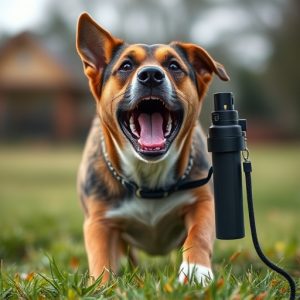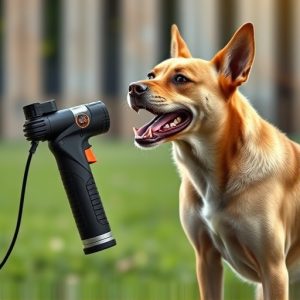Dog Attack Defense: Mastering Mace Use and Pepper Spray Range
In dog attack scenarios, mace or dog pepper spray serves as a vital last-resort defense tool with an…….
In dog attack scenarios, mace or dog pepper spray serves as a vital last-resort defense tool with an optimal range of 20 feet (6 meters) or less. Aiming for sensitive areas like eyes and nose can temporarily deter aggressive dogs, offering escape time or the chance to call for help. Effective use requires proper handling, accessibility, training within the specified range (4-8 feet or 1.2–2.4 meters), understanding legal implications, and considering wind direction to ensure maximum effectiveness without harming bystanders or animals.
In many situations, dog attacks can be unpredictable and dangerous. Knowing how to defend yourself effectively is crucial. One tool gaining popularity as a defense mechanism against dog aggression is pepper spray, specifically designed for these encounters. This article explores the strategic use of mace (or dog pepper spray) during potential attacks, focusing on optimal range and its effectiveness. We’ll also delve into legal considerations and safety tips to ensure responsible usage in such high-stress scenarios.
- Understanding Dog Attack Defense: When and How to Use Mace
- Optimal Range and Effectiveness of Dog Pepper Spray
- Legal Considerations and Safety Tips for Pepper Spray in Dog Attacks
Understanding Dog Attack Defense: When and How to Use Mace
In the event of a dog attack, knowing how and when to deploy defense tools like mace can be life-saving. Mace, specifically designed for animal encounters, offers a non-lethal way to deter aggressive dogs, providing a crucial moment for escape or help to arrive. The optimal range for dog pepper spray, including mace variants, is typically around 20 feet (6 meters), allowing users to maintain distance while neutralizing the threat.
When faced with an attack, aim for the eyes and nose—the sensitive areas that will cause the dog to temporarily retreat. It’s important to remember that mace is most effective as a last resort, after trying to escape or avoid the encounter altogether. Proper handling and understanding of its limitations are key; mace should be carried in an accessible location, and users must be trained to deploy it swiftly and accurately under stressful situations.
Optimal Range and Effectiveness of Dog Pepper Spray
Dog pepper spray, also known as canine pepper spray or dog defense spray, is designed to be an effective and non-lethal deterrent against aggressive dogs. When used correctly, it can provide a crucial window of opportunity for escape or intervention during a dog attack. The optimal range for this type of spray is generally considered to be between 4 to 8 feet (approximately 1.2 to 2.4 meters). This range allows users to apply the spray effectively without putting themselves in direct, close contact with the attacking dog.
The effectiveness of dog pepper spray lies not only in its range but also in its potency. Capsicum-based formulations, which are common in dog defense sprays, act as irritants on the dog’s eyes, nose, and throat, temporarily disabling them. This can give a person valuable time to escape or seek help. However, it’s important to remember that wind, environmental factors, and the dog’s behavior can affect the spray’s performance, so users should be familiar with the product’s instructions and practice its application in controlled situations for optimal results within the stated range.
Legal Considerations and Safety Tips for Pepper Spray in Dog Attacks
When considering pepper spray as a defense against dog attacks, it’s crucial to understand the legal implications and safety measures involved. The use of pepper spray on animals is regulated by local laws, and some regions have strict guidelines or outright bans. Before acquiring and using dog pepper spray, individuals should familiarize themselves with their area’s specific regulations. It’s essential to note that these laws vary widely, determining what constitutes acceptable self-defense and animal control.
Safety tips for deploying dog pepper spray include understanding its optimal range—typically around 2–3 meters (6–10 feet)—and ensuring proper handling. Pepper spray is most effective when the target is within this range, allowing for a direct hit without risking injury to bystanders or causing unnecessary harm to the animal if it moves out of range. Users should also be aware of potential cross-contamination; wind direction and environmental factors can affect the spray’s trajectory and spread, so using it in open areas or downwind can minimize these risks. Regular training and practice are recommended to ensure effective deployment during an actual dog attack situation.
When considering mace or dog pepper spray as a defense against attacks, understanding its optimal range and effectiveness is crucial. While these tools can provide a temporary respite in close-quarters encounters, they are most useful when the threat is within the recommended range of 2-3 meters (6-10 feet). Always follow legal guidelines and safety tips to ensure responsible use. Remember, prevention through training, awareness, and proper handling remains the primary line of defense against dog attacks.


